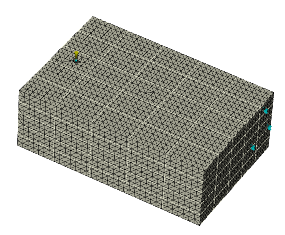The mold mesh is prepared in a single step, or in two steps, depending upon the mold model.
Regardless of the mesh type selected for the part, transient cool mold meshes are composed of tetrahedral (3D) elements. The 3D mold mesh is created in a single step, by default, for CAD/STL molds, but you can select to create it in two steps if you would want to check the integrity of the mold surface mesh before the 3D mesh is generated.
Molds generated by the Mold Surface Wizard, or imported from Autodesk Inventor Tooling are composed of regions for the mold body and curves for the feed system and cooling channels. In these cases, the mold mesh is generated in two steps. A mold surface mesh is created first and it is advised that you check the mesh for errors, particularly around the feed system and cooling channel internal surfaces, and fix them before proceeding. The 3D mesh is generated in a second step.


- CAD mold models
- For imported CAD mold models, the mold can meshed in a single step.
- STL mold models
- For imported STL molds, the mold can meshed in a single step, but to reduce the element count it is advisable to stop the meshing after the surface mesh has been generated in order to apply longer edge lengths to the mold external surfaces. The 3D mesh can then be generated.
- Mold Surface Wizard molds
- A mold created by the Mold Surface Wizard is composed of regions for the mold body, and curves for the feed system and cooling channels. To generate a mold mesh for regions and curves, an initial mold surface mesh is created. You should check the mold surface mesh for errors, paying particular attention to internal surfaces around the feed system and cooling channels. Once you are confident that the mold surface mesh is correct, you can generate the 3D mold mesh.
- Molds imported from Autodesk Inventor Tooling
- A mold created by the Mold Surface Wizard is composed of regions for the mold body, and curves for the feed system and cooling channels. To generate a mold mesh for regions and curves, an initial mold surface mesh is created first. You should check the mold surface mesh for errors, paying particular attention to internal surfaces around the feed system and cooling channels. Once you are confident that the mold surface mesh is correct, you can generate the 3D mold mesh.